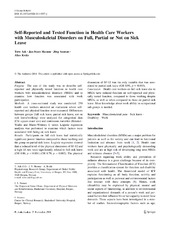Self-Reported and Tested Function in Health Care Workers with Musculoskeletal Disorders on Full, Partial or Not on Sick Leave
Peer reviewed, Journal article
Published version

Åpne
Permanent lenke
https://hdl.handle.net/1956/9643Utgivelsesdato
2014-11-27Metadata
Vis full innførselSamlinger
Originalversjon
https://doi.org/10.1007/s10926-014-9557-ySammendrag
Purpose The aim of this study was to describe self-reported and physically tested function in health care workers with musculoskeletal disorders (MSDs) and to examine how function was associated with work participation. Methods A cross-sectional study was conducted. 250 health care workers attended an evaluation where self-reported and physical function were measured. Differences between groups (full sick leave, partial sick leave, not on sick leave/working) were analyzed for categorical data (Chi square exact test) and continuous variables (Kruskal–Wallis and Mann–Whitney U tests). Logistic regression analysis was performed to examine which factors were associated with being on sick leave. Results Participants on full sick leave had statistically significant poorer function compared to those working and the group on partial sick leave. Logistic regression showed that a reduced level of the physical dimension of SF-12 and a high lift test were significantly related to full sick leave (OR 0.86, p < 0.001) (OR 0.79, p = 0.002). The physical dimension of SF-12 was the only variable that was associated to partial sick leave (OR 0.91, p = 0.005). Conclusion Health care workers on full sick leave due to MSDs have reduced function on self-reported and physically tested function, compared to those working despite MSDs, as well as when compared to those on partial sick leave. More knowledge about work ability in occupational sub-groups is needed.
